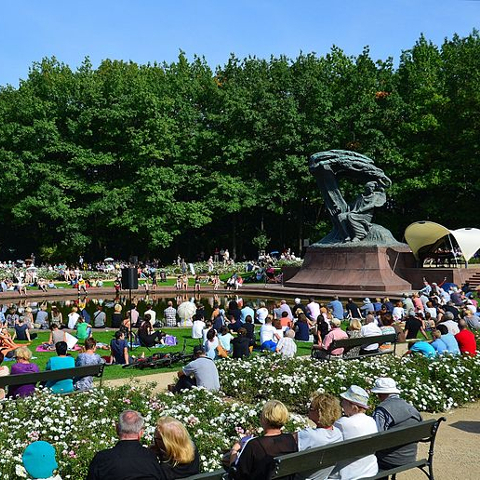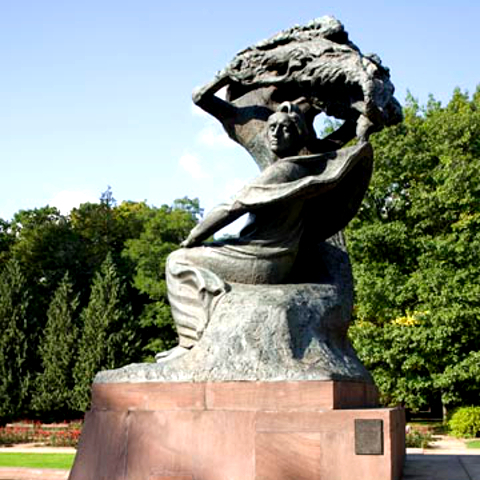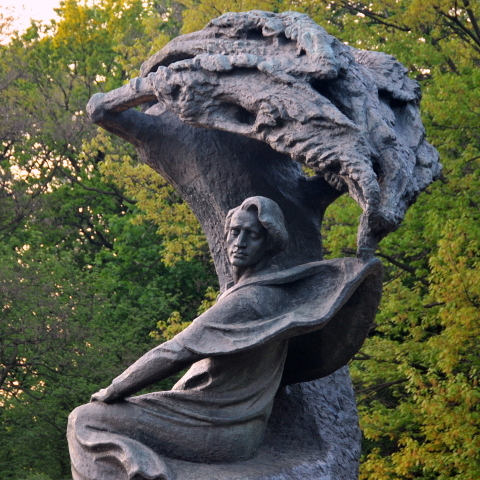Composers / Fryderyk Chopin / Places catalog
Chopin Monument in Łazienki Park
The Fryderyk Chopin monument in Łazienki [Royal baths] Park was designed by Wacław Szymanowski and erected in 1926. Despite, or perhaps partly because of, its turbulent history (to put it mildly), it has become one of the most recognisable symbols of Warsaw. This iconic statue of the great composer has been reproduced on hundreds of postcards and posters. It has been filmed, photographed and exhibited. It is undeniably one of the most popular stops on the itinerary of every tourist who comes to Warsaw.
The story begins no later than 1902 (although we can go back another twenty years to when Chopin’s heart was placed in a pillar in Holy Cross Church in Warsaw and the idea of commemorating him with a fitting monument was raised by the Warsaw Music Society), when, thanks to the efforts of Count Aleksander Dienheim-Szczawiński-Brochocki and others, the Committee for Building a Fryderyk Chopin Monument in Warsaw was set up. The committee spent years working under difficult conditions. They had many bureaucratic obstacles to overcome and financial shortfalls to contend with. It would not be possible here to list all the complexities and complications associated with the monument. A competition to build a Chopin monument was announced in 1908, and the winning entry was selected in 1909. The winner was Wacław Szymanowski, a sculptor from Krakow (although, for several reasons, this did not pass without scandal). Szymanowski’s concept of showing the composer deep in contemplation under an overhanging willow (the original idea was to have a frog at his feet as well) had to wait nearly twenty years for its realisation.
The committee disbanded, but reformed in 1923. Thanks to Szymanowski’s determination, the persistence of successive committee members, and private and public subsidies, the monument was finally ready on 14 November 1926. Szymanowski’s work was unveiled during a two-hour ceremony attended by the nation’s most important dignitaries, including President Ignacy Mościcki. ‘The artist’s concept could only shine in the complete fullness of its expression in its monumental dimensions’, enthused Jan Kleczyński in the Kurier Warszawski [Warsaw courier]. ‘It was conceived on a grand scale at the very outset. Warsaw has been given a mightily beautiful embellishment – Chopin – an everlasting memorial to his genius, and the entire nation has been given a great work of art – one that has made the name of Poland and the sculptor famous’.
The Second World War brought a drastic reversal of fortune in the history of the monument. From 1939, the German invaders consistently pursued their aim of destroying the Polish state which they had occupied – not just physically, but intellectually and culturally as well. To that end, they closed colleges and cultural institutions, carted away works of art and destroyed national memorials.
The Chopin monument in Łazienki Park fell victim to the Nazis in June 1940. In fact, it was the first memorial they blew up. Not a single fragment was salvaged (the head found in Wrocław in 1945, contrary to expectations, belonged to a smaller copy). Every little bit was melted down to make ammunition for the Germans.
The rebuilding of Warsaw after the war included a plan to restore the Chopin monument, which had already assumed significance as one of the most important symbols of Polish national culture, to Łazienki Park. After many years of studies and research, the monument was recreated according to its original design. It was finally unveiled on 11 May 1958 and stands there to this day.
-

Chopin concerto in the Royal Baths Park. (creative commons)
-

The Chopin Monument in the Royal Baths Park. Phot. Czesław Czapliński.
-

The Chopin Monument in the Royal Baths Park. Phot. Czesław Czapliński.